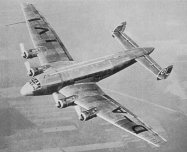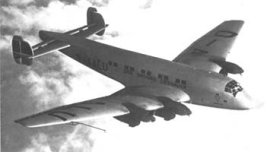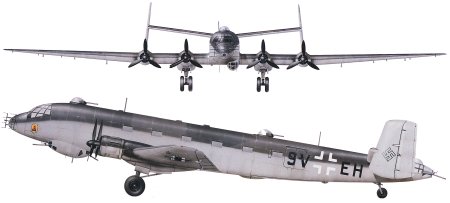
Junkers Ju 90/290
After its Ju 89 bomber was cancelled, Junkers was keen to gain something from the effort expended on the aircraft. By mating a new fuselage with the Ju 89's wings, a new transport aircraft, known as the Ju 90 was produced. Further development of this design led to the Ju 290 maritime reconnaissance aircraft and ultimately to the giant, six-engined Ju 390 which flew to within 20 km (12 miles) of the US coast.
Lufthansa ordered eight Ju 90s and South African Airways a further two aircraft, but all were impressed into Luftwaffe squadrons. In 1940 work started on a new version, designated Ju 290 which was bigger than the original. It was to be built in both transport and maritime reconnaissance versions.
The Ju 290A-0 and A-1 transport aircraft were immediately put into service since the Luftwaffe was desperately short of transport capacity. The A-2 to A-5 variants were maritime reconnaissance models, and the A-6 was intended as a transport for the personal use of Adolf Hitler. The A-7 and A-8 were to be missile armed anti-ship aircraft.
About 40 Ju 290s, were built, nearly half of them by Letov in Czechoslovakia. Maritime versions were based in southwest France and used to locate Atlantic convoys for the German U-boats. The Ju 290A-6 was completed as a 50-seat VIP transport. It flew to Barcelona in April 1945 and later served with the Spanish air force until the mid 1950s. Ju 290B, D and E bomber variants, the C transport/reconnaissance aircraft and the MS mine-clearer were all abandoned during the final years of the war.
 |
 |
 |
| The Ju 390 V2 was the second of only two aircraft completed and remains the largest conventional aircraft to be built in Germany. |
With World War II imminent, Junkers was not allowed to use the strategically important Jumo 211 or DB 600 engines that had been tested on the prototypes. |
If more Ju 290A-7s, with their Henschel Hs 293, 294 and Fritz X missiles and Hohentwiel radar had been delivered, they would have made a powerful anti-shipping force. |
|
Junkers Ju 90/290 (Technical Specification) |
| Role |
Long-range maritime reconnaissance aicraftr |
| Manufacturer |
Junkers |
| Maximum Speed |
440 kmh (273 mph) |
| Maximum Range |
6,150 km (3,813 miles) |
| Ceiling |
6,000 meters (19,700 feet) |
Weight
Empty
Maximum Takeoff |
40,970 kg (90,134 lbs)
44,970 kg (98,934 lbs) |
Dimensions
Wingspan
Length
Height
Wing Area |
42.00 meters (137 ft 8 in)
28.64 meters (93 ft 11 in)
6.83 meters (22 ft 5 in)
203.6 square meters (2,213 sq ft) |
| Engines |
Four BMW 801D 14-cylinder air-cooled radial engines each providing 1268-kW (1,700-hp) |
| Armament |
One 20 mm (0.79 in) MG 151 cannon in each of two dorsal turrets, the tail position, each waist position and the ventral gondola
One 13 mm (0.51 in) machine-gun in the rear of the gondola |
Photo Gallery
Click here to submit your photo
| Have A Passion For Aircraft? |
Subscribe to our 14 series FREE newsletter
delivered weekly on World War 2 Aircraft factfile... |
| NB:- We hate spam as much as you do, so your email address will NEVER be shared with or sold to anyone else. That's a Guarantee. |
|
|





